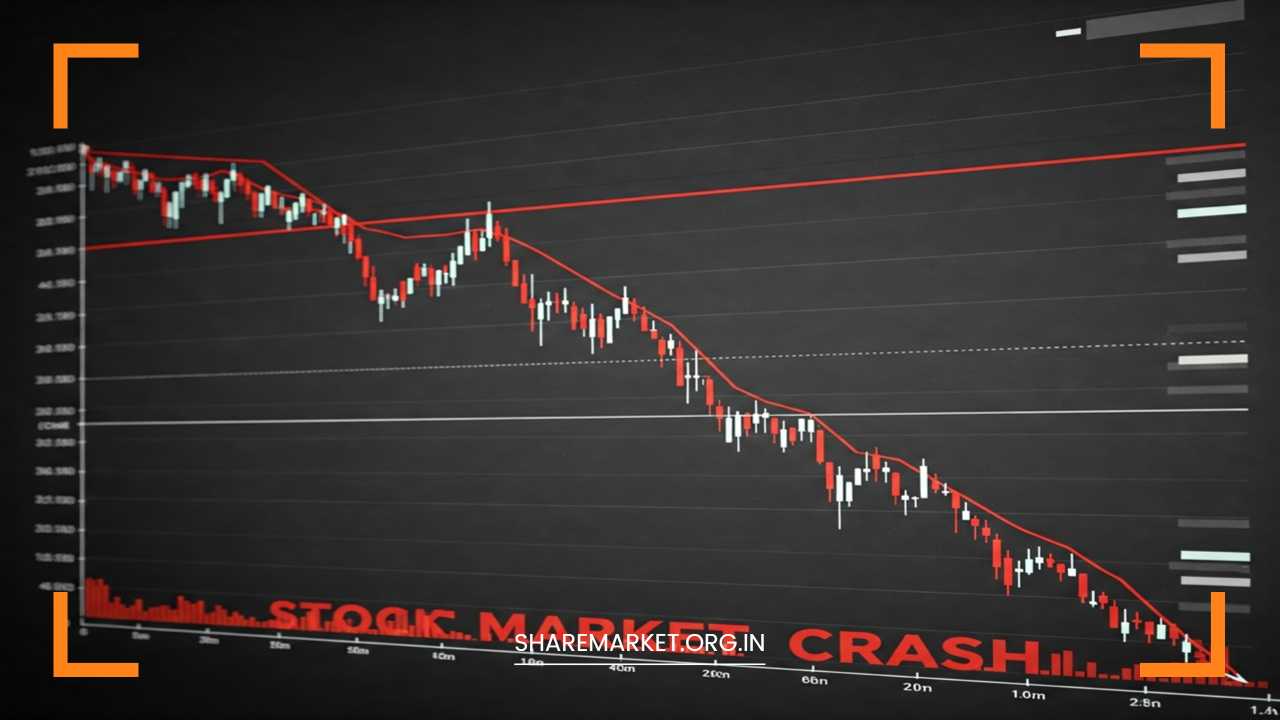Share Market Crash: 3 Key Reasons Behind the 1000-Point Drop in Sensex and Chaos

Share Market Crash
Share Market Crash: Why is There Panic in the Stock Market? Sensex Down 1000 Points – 3 Key Reasons Behind the Significant Decline
The Indian stock market opened the new financial year with a sharp and unsettling decline, sending shockwaves through investors.
The Sensex plummeted by over 1,000 points, and the Nifty followed suit with a decline of more than 1%. As the markets opened on April 1, the atmosphere was filled with uncertainty and fear, compounded by global economic factors and domestic concerns.
A major fall was seen in a broad range of sectors, particularly in IT stocks, and the total market capitalization of companies listed on the BSE dropped by nearly ₹3 lakh crore, now standing at ₹409.81 lakh crore.
Market Overview and Early Trends:
By 11:05 AM, the BSE Sensex had dropped by 1,106.23 points or 1.43%, hitting a low of 76,308.92, while the NSE Nifty lost 243.25 points or 1.03%, settling at 23,276.10.
Major stocks in sectors such as IT, finance, and automobiles took significant hits, with companies like Infosys, Tata Consultancy Services (TCS), Bajaj Finance, HDFC Bank, Axis Bank, Bajaj Finserv, HCL Technologies, and Maruti Suzuki all seeing steep declines.
This marked the beginning of what appeared to be a day of heightened volatility in the stock market.
For many retail and institutional investors, the sharp downturn was a reminder of how global events and domestic factors can dramatically impact stock market performance.
Analysts are pointing to three key reasons behind today’s crash, each of which contributes to the overall atmosphere of fear and uncertainty in the market.
1. Trump’s Plan to Impose Reciprocal Tariffs: Global Trade Concerns
One of the biggest contributors to today’s market panic is the anticipation of US President Donald Trump’s impending announcement regarding the imposition of reciprocal tariffs on multiple countries.
This announcement, set for April 2, has sent tremors through global markets, including India. Trump has been referring to this upcoming event as “Liberation Day” for America.
The proposed tariffs are seen as part of his broader strategy to address what he calls unfair trade practices by several countries.
The tariffs would primarily target trade partners such as China, Mexico, and Canada, and affect a wide range of industries, including automobiles, pharmaceuticals, steel, aluminum, copper, semiconductors, and lumber.
VK Vijayakumar, Chief Investment Strategist at Geojit Investment Services, explained, “Global stock markets are currently in a holding pattern, waiting for Trump’s official announcement.
Investors are anxious to know which sectors, industries, and countries will be most affected by these tariffs.
The lack of clarity surrounding the specifics of the tariffs is creating uncertainty, making the market react nervously.”
Tariff wars between major economies, such as the US and China, have often led to significant disruptions in global supply chains, increased costs for businesses, and retaliatory measures that could hurt economic growth.
In the case of India, while it may not be a direct target of these tariffs, there are concerns about the indirect effects, such as disruptions in global trade flows and potential shifts in investor sentiment, leading to stock market declines.
2. Rise in Crude Oil Prices: Concerns for India’s Trade Deficit
Another major factor exacerbating the current market panic is the recent surge in global crude oil prices. Brent crude oil, the international benchmark, saw a sharp 1.51% increase, reaching $74.74 per barrel.
This uptick in crude prices is worrying for India, as the country is one of the world’s largest importers of oil.
Rising oil prices put additional strain on India’s trade balance, increasing the import bill and exacerbating inflationary pressures.
India is highly sensitive to fluctuations in oil prices because of its dependence on oil imports to meet its energy needs.
A sustained increase in crude prices can lead to higher fuel costs, which subsequently affects consumer spending, transportation costs, and production expenses across various industries.
Higher energy costs can also weigh down corporate profits, leading to a reduction in investor confidence.
For investors in the Indian stock market, the rise in crude oil prices is a sign of potentially slower economic growth, which could translate to weaker corporate earnings, particularly in sectors like transportation, logistics, and manufacturing, which are heavily reliant on fuel.
This is why the surge in crude oil prices has become one of the focal points in the market’s recent decline.
3. Risk of a US Recession: Global Economic Fears
Adding to the global economic uncertainty is the increasing possibility of a recession in the US. Goldman Sachs, one of the leading global brokerage firms, recently raised its probability of a US recession to 35%, up from the earlier estimate of 20%.
The firm cited the economic fallout from Trump’s trade policies, particularly the potential tariffs, as a key driver behind this revision.
If the US economy were to enter a recession, it could lead to a significant slowdown in global economic growth, further hurting investor sentiment.
Moreover, Goldman Sachs has also raised concerns about a potential technical recession in the European Union, which could have a ripple effect on the global economy.
If these major economies experience a slowdown, it would impact global trade, reduce demand for commodities, and create further turbulence in global stock markets.
A slowdown in the US economy could also affect corporate earnings and increase market volatility, as investors adjust their expectations for growth and risk.
The risk of a recession in both the US and Europe is creating a sense of global uncertainty, prompting investors to reconsider their strategies and move away from riskier assets like stocks.
This fear of a global economic downturn has led to widespread sell-offs in major equity markets, contributing to the sharp decline in the Indian stock market.
What Does the Technical Chart Say? Market Outlook
As for the technical outlook, analysts are suggesting that the market needs to see a substantial move above the 23,700–23,750 range to regain strength and confidence.
According to Anand James, Chief Market Strategist at Geojit Investments, “If the Nifty fails to break above this key level, we may continue to see sideways trading with a downward bias. A potential target for the index could be the 23,300 level.”
James also points out that a breakout beyond the 23,750–23,300 range could lead to a sharp recovery of at least 250 points in the Nifty, which may offer some relief to investors.
However, until such a breakout occurs, the market is likely to remain volatile, with investors keeping a close watch on global developments, especially those related to trade tariffs and oil prices.
Final Remarks
Today’s dramatic fall in the Indian stock market is the result of a confluence of global and domestic factors that have spooked investors.
With uncertainties surrounding Trump’s tariff plans, rising crude oil prices, and growing fears of a US recession, the market is facing significant headwinds.
Investors are left navigating through a volatile environment, with little clarity on the near-term outlook. As such, many are adopting a cautious stance, awaiting clearer signals before making further investment decisions.
The coming days will be crucial in determining whether the market can stabilize or if the downward trend will continue.
Investors, both retail and institutional, will need to stay vigilant, carefully monitoring the unfolding global economic developments and adjusting their portfolios accordingly.

















